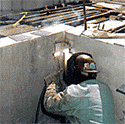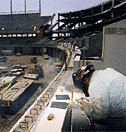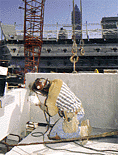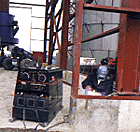Stick Welding - How To Create High Quality Welds
Stick welding is the most common form of arc welding, but creating a good weld may not be easy for the beginner. Unlike wire welding where you basically "point and shoot," stick welding has a higher skill level and requires mastery of certain techniques.
This article will offer tips that you can follow to increase your chances of creating a high quality stick weld - right from the start. It will also discuss how to troubleshoot problems and correct them.
1. Select Steel in the Normal Range
Whenever possible, select steel within the "normal range," these include AISI-SAE 1015 to 1025 steels with 0.1 percent maximum silicon and sulfur content under .035 percent. Selecting these steels will make the stick welding process easier since they can be welded at fast speeds with minimum cracking tendencies.
If you are welding with low-alloy steels and carbon steels with chemistry compositions above the "normal range", they will have a tendency to crack, particularly when welding on heavy plate and rigid structures. Because of this, you should use special precautions. In addition, steels with high sulphur and phosphorus contents are not recommended for production welding. If they must be welded, use small diameter, low hydrogen electrodes. Welding with a slow travel speed will further keep the puddle molten allowing gas bubbles time to boil out, creating a better-finished weld.
2. Choose a Joint Position and Electrode that is Conducive to the Metal
Joint position can have a great affect on finished weld quality. When welding on 10 to 18 gauge sheet steel, the fastest travel speeds are obtained with the work positioned at a 45 to 75 degrees downhill angle. Also, don't overweld or make a weld that is larger than needed for joint strength - this may lead to burnthrough.
For welding mild steel plate with a thickness greater than or equal to 3/16", it is best to have the work positioned flat, because this will make operator manipulation of the electrode the easiest. Lastly, high carbon and low-alloy steel plate can best be welded with the work in the level position.
3. Follow Simple Principles for Joint Geometry and Fitup
Joint dimensions are chosen for fast welding speeds and good weld quality. Proper joint geometry is based upon some simple principles:
- Fitup must be consistent for the entire joint. Since sheet metal and most fillet and lap joints are tightly clamped for their entire length, gaps or bevels must accurately be controlled over the entire joint. Any variations in a given joint will force the operator to slow his or her welding speed to avoid burnthrough and manipulate the electrode to adjust for the fitup variation.
- Sufficient bevel is required for good bead shape and penetration; insufficient bevel prevents the electrode from getting into the joint. For example, a deep, narrow bead may lack penetration and has a strong tendency to crack.
- Sufficient root opening is needed for full penetration, while excessive root opening wastes weld metal and slows welding speed. It is important to note that the root opening must be consistent with the diameter of the electrode being used.
- A root face or a backup strip is required for fast welding and good quality. Feather edge preparations require a slow costly seal bead. However, double V butt joints without a land are practical when the seal bead cost is offset by easier edge preparation and the root opening can be limited to approximately 3/32".
- In general, weld seal beads on flat work with 3/16" AWS E6010 at approximately 150 amps DC+. Use 1/8" at approximately 90 amps DC+ for vertical, overhead, and horizontal butt welds. For low hydrogen and seal beads, weld with an AWS EXX18 electrode at approximately 170 amps.
4. Avoid Buildup and Overwelding
Fillets should have equal legs and a nearly flat bead surface. Buildup rarely should exceed 1/16". Extra buildup is costly in material and time, adds little to weld strength and increases distortion. For example, doubling the size of a fillet requires four times as much weld metal. Also, it costs 2/3 more to butt weld a single-V with 1/8" land and 1/32" root opening when the excess buildup approaches 1/8".
5. Clean the Joint Before Welding
To avoid porosity and attain the ideal weld travel speeds, it is important to remove excessive scale, rust, moisture, paint, oil and grease from the surface of joints. If such elements cannot be removed, use AWS E6010 (Fleetweld® 5P+) or AWS E6011 (Fleetweld® 35 or Fleetweld® 180) electrodes to penetrate through the contaminants and deeply into the base metal. Slow the travel speed to allow time for gas bubbles to boil out of the molten weld before it freezes.
6. Choose the Right Electrode Size
Large electrodes weld at high currents for high deposit rates. Therefore, use the largest electrode practical to be consistent with good weld quality. But, electrode size may be limited especially on sheet metal and root passes, where burnthrough can occur. As a general rule, 3/16" is the maximum electrode size practical for vertical and overhead welding, while 5/32" is the maximum size practical for low hydrogen. In addition, joint dimensions sometimes limit the electrode diameter that will fit into the joint.
Troubleshooting Weld Defects
Here are some of the most common stick welding problems and how to correct them:
Spatter
Although spatter does not affect weld strength, it does create a poor appearance and increases cleaning costs. There are several ways to control excessive spatter. First, try lowering the current. Make sure it is within the range for the type and size electrode you are welding with and that the polarity is correct. Another way to control spatter is to try a shorter arc length. If the molten metal is running in front of the arc, change the electrode angle. Finally, look for arc blow conditions (commonly referred to as a wandering arc), and be sure the electrode is not wet.
Undercutting
Undercutting is frequently just an appearance problem, but it can impair weld strength when the weld is loaded in tension or subjected to fatigue. To eliminate undercut, reduce current and slow travel speed, or simply reduce size until you have a puddle size you can handle. Then change the electrode angle so the arc force holds the metal in the corners. Use a uniform travel speed and avoid excessive weaving.
Wet electrodes
If polarity and current are within the electrode manufacturer's recommendations but the arc action is rough and erratic, the electrodes may be wet. Try dry electrodes from a fresh container. If the problem recurs frequently, store open containers of electrodes in a heated cabinet.
Wandering arc
With DC welding, stray magnetic fields cause the arc to wander from its aimed course. This is a greater problem at high currents and in complex joints. To control a wandering arc, the best option is to change to AC welding. If that doesn't work, try using lower currents and smaller electrodes or reduce the arc length. In addition, you can change the electrical path by shifting the work connection to the other end of the piece or by making connections in several locations. You may also do this by welding toward heavy tacks or finished welds, using run-out tabs; adding steel blocks to change work current path or tacking small plates across the seam at the weld ends.
Porosity
Most porosity is not visible. However, since severe porosity can weaken the weld, you should know when it tends to occur and how to combat it. Begin by removing scale, rust, paint, moisture and dirt from the joint. Be sure to keep the puddle molten for a longer time to allow gases to boil out before it freezes. If the steel has a low carbon or manganese content, or a high sulfur (free machining steel) or phosphorus content, it should be welded with a low-hydrogen electrode. Sometimes the sulfur content of free machining steels can be high enough to prevent successful welding. Minimize admixture of base metal into weld metal by using low current and fast travel speeds for less penetration. Or, try using a shorter arc length. A light drag technique is recommended for low hydrogen electrodes. For surface holes, use the same solutions that are used for porosity. If you are using AWS E6010 or 11 electrodes, make sure that they are not too dry.
Poor Fusion
Proper fusion means the weld must physically bond strongly to both walls of the joint and form a solid bead across the joint. Lack of fusion is often visible and must be eliminated for a sound weld. To correct poor fusion, try a higher current and a stringer bead technique. Be sure the edges of the joint are clean, or use an AWS E6010 or 11 electrode to dig through the dirt. If the gap is excessive, provide better fitup or use a weave technique to fill the gap.
Shallow Penetration
Penetration refers to the depth the weld enters into the base metal, and usually is not visible. For full- strength welds, penetration to the bottom of the joint is required. To overcome shallow penetration, try higher currents or slower travel. Use small electrodes to reach down into deep narrow grooves. Remember to allow some gap at the bottom of the joint.
Cracking
Cracking is a complex subject because there are many different types of cracks that occur in different locations throughout a weld. All cracks are potentially serious, as they can lead to complete failure of the weld. Most cracking is attributed to high carbon or alloy content, or high sulfur content in the base metal.
To control this cracking, try these tips:
- Weld with low hydrogen electrodes
- Use high preheats for heavier plate and rigid joints
- Reduce penetration by using low currents and small electrodes. This reduces the amount of alloy added to the weld from melted base metal
- Fill each crater before breaking the arc
- On multiple pass or fillet welds, be sure the first bead is of sufficient size and of flat or convex shape to resist cracking until the later beads can be added for support. To increase bead size, use slower travel speed and a short arc technique or weld 5 degrees uphill. Always continue welding while the plate is hot
- Rigid parts are more prone to cracking. If possible, weld toward the unrestrained end. Leave a 1/32" gap between plates for free shrinkage movement as the weld cools. Peen each bead while it is still hot to relieve stresses
Conclusion
By following the tips offered here, even a beginner can create a high quality weld. And, if you are experiencing problems, being able to troubleshoot and make corrections will also turn a beginning stick welder into a professional in no time.





